The following text is excerpted and adapted from Chapter 5, "The Weapons and Warfare of Tomorrow," in Yesterday's Tomorrows: Past Visions of the American Future by Joseph J. Corn and Brian Horrigan.
This book can be purchased over the web from Amazon.com-earth's largest bookstore. Your support is appreciated.
Click here to view our extensive bibliography.

 "Although Americans have long cherished the myth that they are an unusually peace-loving people, they have paradoxically shown an intense fascination with the equipment and gadgets of warfare. World War I deepened this attraction, especially in the weapons of the future. Part of this interest in military hardware stems from our tendency to embrace technology in general, to romanticize the promise of machines to benefit society. The American economic system has also encouraged the substitution of labor-saving machinery for human workers, although it has traditionally been wary of militarism and of large, standing armies. The American way of war has been to fight with sophisticated war machines rather than great numbers of troops."
"Although Americans have long cherished the myth that they are an unusually peace-loving people, they have paradoxically shown an intense fascination with the equipment and gadgets of warfare. World War I deepened this attraction, especially in the weapons of the future. Part of this interest in military hardware stems from our tendency to embrace technology in general, to romanticize the promise of machines to benefit society. The American economic system has also encouraged the substitution of labor-saving machinery for human workers, although it has traditionally been wary of militarism and of large, standing armies. The American way of war has been to fight with sophisticated war machines rather than great numbers of troops."
"Weapons envisioned by Americans have tended to reflect their strongly held values, such as the importance historically attached to mobility. Just as transportation has figured greatly in visions of the civilian future, so it has in American visions of tomorrow's warfare. Certain weapons, the symbols and exemplars of power, influenced the shape of American military visions. The cannon of Jules Verne's day, the battleship of the early twentieth century, and the airplane in the mid-twentieth century each revolutionized warfare, and visionaries incorporated these successful machines into their predictions."
"While the visions of tomorrow's weapons have changed, so too have the individuals making them. In the twentieth century, artists have increasingly provided these visions. Advances in printing led to a rapid and dramatic departure from the primarily verbal evocations of future life and warfare typical of late nineteenth-century fiction. Illustrations in hobby magazines, pulp science fiction, and Sunday newspaper supplements began to depict the fantastic 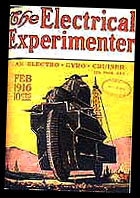 weapons of tomorrow, often in lurid color. Before 1945 the concepts for these visionary proposals came from independent inventors and amateur defense enthusiasts. The military establishment, conservative by tradition, avoided speculation about tomorrow's weapons. Not until after World War II, when the benefits of sustained research and development in producing powerful new weapons became clear, did members of the armed services, in league with scientists and engineers in universities and the defense industry, come to monopolize the crystal ball through which tomorrow's weapons are glimpsed."
weapons of tomorrow, often in lurid color. Before 1945 the concepts for these visionary proposals came from independent inventors and amateur defense enthusiasts. The military establishment, conservative by tradition, avoided speculation about tomorrow's weapons. Not until after World War II, when the benefits of sustained research and development in producing powerful new weapons became clear, did members of the armed services, in league with scientists and engineers in universities and the defense industry, come to monopolize the crystal ball through which tomorrow's weapons are glimpsed."
WORLD WAR I
"Although the United States did not enter World War I until 1917, Americans were horrified by the carnage on the western front. The opposing armies, huddled in elaborate networks of trenches, had fought to an early but bloody stalemate. The problem was that entrenched troops, equipped with the recently perfected machine gun, were virtually invincible. They could easily mow down enemy soldiers who attacked."
"American inventors offered visionary solutions to break the stalemate on the western front. The first wave of offensive weapons could suposedly resist the machine gun and carry the attack directly to men in the trenches. The very names of these aggressive fighting machines -- Electro-Gyro Cruiser (1916), Trench Destroyer (1917), Submarine Land Dreadnaught (1924) - suggest their nature: they were in effect huge, land-based battleships. Such machines never came close to production. But their frequent appearance in the popular culture of the period attests to the American belief that there had to be some technological solution to a situation as grisly and barbaric as trench warfare with machine guns. The land dreadnaughts were conceived out of an American fondness for large and complex mechanisms and recall other examples of engineering colossi, such as the giant caloric engine designed by steamboat builder John Erickson in the mid-nineteenth century."
"The second type of visionary weapon popular in the World War I years relied on electricity for effectiveness instead of size. By harnessing the seemingly magical power of this new force, some enthusiasts believed they could creae the ultimate weapon. In 1918 Hugo Gernsback, known as a publisher, radio experimenter, and later as the founder of the first science fiction magazine, offered the idea of an automatic soldier to be built of "shell-proof Tungsten steel" and powered by electricity. 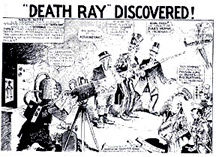 He envisioned dozens of these automatons replacing human soldiers in the forward line of trenches firing on the enemy according to directions received by radio."
He envisioned dozens of these automatons replacing human soldiers in the forward line of trenches firing on the enemy according to directions received by radio."
"The most spectacular of the proposed applications of electricity was the death ray, a concentrated beam of electricity that could destroy people, vehicles, or structures. H.G. Wells is usually credited with first imagining the death ray, wielded by the invading Martians in his 1898 novel War of the Worlds, and may have been inspired by the discovery of X-rays a few years earlier. Until lasers were invented, there was no theoretical basis for thinking that an effective death ray could be built. Yet in the early twentieth century the idea was popular in fiction and was publicized by Nikola Tesla, a prominent if somewhat eccentric technologist employed by Westinghouse."
POST-WORLD WAR I
"During the 1920s and 1930s, the airplane inspired most visions of future weaponry and warfare. Although most planes had not played a decisive part in the outcome of World War I, they convinced many people that future wars would be largely aerial. One of the most vocal prophets of air power and a strong promoter of military aerial preparedness was Army Colonel William "Billy" Mitchell who believed the bomber had rendered the battleship obsolete. However until war threatened in the late 1930s, American military aeronautics received little support or funding from Congress. Visionary inventors, however, offered imaginative machines to wage the aerial wars of the future. More interesting than the pure airplanes were hybrid flying weapons like the flying tank. According to its inventor, 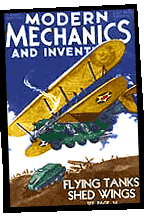 knowledge of the existence of this weapon and its possession would "be a greater guarantee of peace than all the treaties that human ingenuity can concoct." Such hopes were just one more instance of the American habit of believing in that ultimate weapon, a technological fix, as a substitute for politics in eliminating world conflicts."
knowledge of the existence of this weapon and its possession would "be a greater guarantee of peace than all the treaties that human ingenuity can concoct." Such hopes were just one more instance of the American habit of believing in that ultimate weapon, a technological fix, as a substitute for politics in eliminating world conflicts."
WORLD WAR II TO VIETNAM
"During World War II the development of many new weapons dramatically altered the course of combat. In retrospect, the most obvious was the atomic bomb which resulted from the collaboration between the government, military, and scientific establishment. Similar collaborations involving scientists and the military had led to radar, jet aircraft, and the proxiity fuse, a device that could cause a bomb or shell to explode above or near a target, with much greater destructiveness. The global conflict impressed the military with the need for ongoing weapons research and development. Thus as the United States moved into peacetime, the military began to devote systematic attention to scientific research. No longer was speculation about the tanks, planes, and other weapons of tomorrow confined to amateurs, published in hobby magazines for the edification or amusement of the general public. It became the province of what President Eisenhower called "the military industrial complex." Military contractors even exploited the techniques developed by auto makers to sell their future weapons systems. 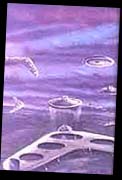 Believing in the adage of a picture being worth a thousand words, they hired illustrators to visualize futuristic weapons in action. These images were promoted at trade shows and in the pages of periodicals like Army Information Digest"
Believing in the adage of a picture being worth a thousand words, they hired illustrators to visualize futuristic weapons in action. These images were promoted at trade shows and in the pages of periodicals like Army Information Digest"
"One of the more interesting post-war ideas to improve combat practices was to make the infantryman more mobile. To attain this goal, to liberate the infantryman from the mud and muck, engineers came up with many ideas. One proposal was the Hiller flying platform, lifted by a ducted fan and steered by shifting body weight. A similar one-man flying machine was the De-Lackner " Aerocycle" powered by an outboard motor. But the invention that most captured the public imagination was the rocket backpack or Small Rocket Lift Device (SRLD) developed by Bell Aerosystems for the army and tested in 1961. The Bell device was reminiscent of Buck Rogers,whose rocket belt enabled him to speed away from dangerous criminals. Yet the Bell SLRD found its most dramatic application not in the army, where its hundred-pound weight and twenty-six-second flight range proved terribly limiting, but in Hollywood, where James Bond employed it to good advantage in the movie Thunderball"
"Yet the rocket backpack was not nearly as fanciful as other futuristic weapons imagined by the military in the 1960s. There was, for example, a proposed flying tank turret. This turret could detach itself from a tank, take to the air like a flying saucer (with crew inside), reconnoiter the surrounding territory, and then return to the tank, attach itself, and continue the battle."
"The army had other dreams that were 'way out' including a vehicle that had legs to walk though the jungle or over stream beds, carrying troops or supplies through terrain impassable by ordinary wheeled or tracked vehicles. The concept was related 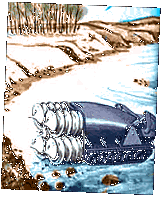 to American experience in Southeast Asia, where transportation was frustratingly difficult. General Electric built a prototype walking machine for the army which worked under test conditions, but when it was disconnectd from its hydraulic umbilical cord, the machine was useless. Instead of walking into battle in Viet Nam, the invention has so far been employed only by the legions of evil in the popular movie The Empire Strikes Back."
to American experience in Southeast Asia, where transportation was frustratingly difficult. General Electric built a prototype walking machine for the army which worked under test conditions, but when it was disconnectd from its hydraulic umbilical cord, the machine was useless. Instead of walking into battle in Viet Nam, the invention has so far been employed only by the legions of evil in the popular movie The Empire Strikes Back."
"Two other army visions from the 1960s that similarly mirror the frustrations of Viet Nam are the Mole and the Mudslinger. As its name suggests, the Mole would dig tunnels through mountains, enabling troops and vehicles to move directly toward a target. Mudslinger would move into "deep mud" as Ordinance Magazine described its mission, "leaving a compacted and chemically-hardened road in its wake." The machine would in effect remake the landscape of the underdeveloped world into something approximating the United States, eating into Southeast Asian swamps and, after a brief period of digestion, excreting American-style highways. Although Mudslinger was only an imaginative construct, an engineering vision, it ironically symbolized the United States' broader policy in Viet Nam, an effort to refashion a foreign environment better fit to American needs and expectations."
AFTER VIETNAM
"After the American withdrawl from Viet Nam, the history of military hardware futurism once again shifted. By the latter 1970s the computer revolution was underway. Today's greatly enhanced capacity 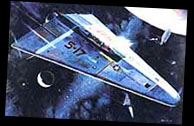 to collect, store, process, and send information is creating what has been called the "electronic battlefield of the future." The look of this new battlefield, however, does not lend itself to graphic depiction."
to collect, store, process, and send information is creating what has been called the "electronic battlefield of the future." The look of this new battlefield, however, does not lend itself to graphic depiction."
"A terrifying component of the electronic warfare of the future is the laser or particle beam weapon. A major component of Ronald Reagan's "Star Wars" program, lasers were said to be able to provide America with an impenetrable shield against attack by nuclear missiles. Yet the Star Wars vision was less futuristic than nostalgic. It assumed that a technological breakthrough could provide Americans with total security and invincibility. In the past, similar assumptions had also proved to be illusions. One recalls, for example, the preposterous land dreadnaughts that chugged across the covers of popular science magazines in the World War I years. Such fantasies are immensely appealing and satisfy a childlike urge to be safe and secure. Yet security based on the falsely comforting idea that some super weapon can make us safe is only an illusion."

________________________

Despite the fact history teaches that there is no super weapon to insure our future safety and security,. Americans continue to search for one. The Mjolnir AP-1 rifle by the New Crusade, Inc. is an example.  The image presented here is not of a toy, but is an early engineering drawing for what was proposed to be a real gun. Named after the hammer used by the Norse God Thor to forge his lightning bolts, the Mjolnir was developed by the Armaments Division of the New Crusade, Inc, a company which is engaged in "projected energy" weapons research. This gun projects high-voltage electric pulses to a maximum output of 3kJ (kilo-joules) and has a discharge rate which is variable to 400Hz. Its maximum range is approximately seven miles. It weighs 22 pounds and can be set at "sting," "stun," or "kill." Because some of the components of this weapon resisted miniaturization this weapon was never actually produced, although it is now being retooled for large weapons platforms like helecopters, tanks, and battleships. The drawing for the Mjolnir were sent in by Patrick Bishop, CEO of The New Crusade. Thank you Patrick!
The image presented here is not of a toy, but is an early engineering drawing for what was proposed to be a real gun. Named after the hammer used by the Norse God Thor to forge his lightning bolts, the Mjolnir was developed by the Armaments Division of the New Crusade, Inc, a company which is engaged in "projected energy" weapons research. This gun projects high-voltage electric pulses to a maximum output of 3kJ (kilo-joules) and has a discharge rate which is variable to 400Hz. Its maximum range is approximately seven miles. It weighs 22 pounds and can be set at "sting," "stun," or "kill." Because some of the components of this weapon resisted miniaturization this weapon was never actually produced, although it is now being retooled for large weapons platforms like helecopters, tanks, and battleships. The drawing for the Mjolnir were sent in by Patrick Bishop, CEO of The New Crusade. Thank you Patrick!



